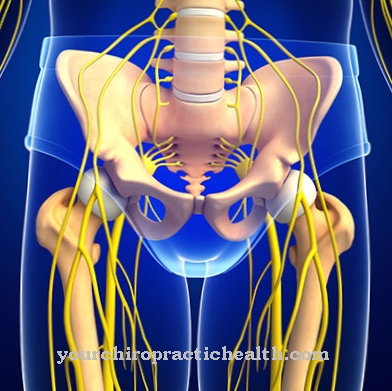The term Germ cell tumor includes a multitude of different tumors that arise from the germ cells. The characteristics of these tumors are strongly dependent on gender.
What is a germ cell tumor?

© designua - stock.adobe.com
A Germ cell tumor has its starting point in the germ cells of the organism. There are very different forms of this disease. The dignity (value or danger of the course) of the tumors depends on gender. In men, in addition to a few benign neoplasms, malignant masses very often occur, while in women the tumor is usually benign.
Germ cell tumors in men are divided into seminomas (starting from the semen) and non-seminomas. The seminomas are malignant testicular tumors that often appear between the ages of 30 and 40 years. Most germ cell tumors in men are seminomas. The non-seminomas in men include yolk sac tumor, chorionic carcinoma, embryonic carcinoma and teratoma. There are also malignant forms among the non-seminomials. In women, teratomas, yolk sac tumors, dysgerminomas and chorionic carcinomas are differentiated. Each of these different forms of germ cell tumors represent specific diseases with different prognoses for healing.
causes
The causes of germ cell tumors are diverse and depend on what form they are. The man's seminomas arise from the degeneration of the spermatogonia. As primordial sperm cells, spermatogonia are the stem cells in the germinal epithelium of the testicle. The degeneration of these cells takes place in different steps. First, the DNA increases in the gametes present as sperm cells, which leads to a tetraploid cell nucleus.
In the further course the proportion of DNA decreases more and more, whereby the seminoma cells become aneuploid. This means that the number of chromosomes in the cell becomes completely irregular. As a result, aggressive cell growth takes place. Another germ cell tumor in men is embryonic carcinoma. Here, scattered embryonic stem cells degenerate. This type of cancer often occurs between the ages of 20 and 30.
The germ cell tumors that occur in women are 95 percent mostly benign teratomas of the ovaries. Teratomas are the growth of stem cells. Depending on how differentiated the stem cells are, the tumor can contain tissue from various organs, such as fatty tissue, muscles, hair, teeth, as well as bone, cartilage, mucous membrane or nerve tissue. Men can get teratomas too.
The dysgerminoma of the ovary is specific to women, which can be compared to the seminoma of men. It arises from undifferentiated germ cells. Germ cell tumors affecting both sexes are yolk sac tumor from undifferentiated cells from early embryogenesis and choriocarcinoma from placental cells.
Symptoms, Signs & Ailments
The symptoms of the individual germ cell tumors are different. Teratomas are benign tumors of the ovaries or malignant tumors of the testes that arise from differently differentiated stem cells and can therefore take on characteristics of certain types of tissue. The seminoma, in turn, manifests itself in men between the ages of 30 and 40 as a painless swelling of the testicle.
The success of the treatment depends on the stage of the disease. In male embryonic carcinoma of the testicle, necrosis, bleeding and cysts occur. The dysgerminoma in women is similar to the seminoma in men and appears as a solid tumor on the genitals of girls, adolescents or pregnant women. The chorionic carcinoma in men is a specialty. Because the starting cells of this germ cell tumor are embryonic placental cells, gynecomastia (breast development) can occur.
Diagnosis & course of disease
The diagnosis of a germ cell tumor depends on which disease it is. Often, suspicious diagnoses can already be made based on the symptoms, but these still have to be confirmed by laboratory tests. In male chorionic carcinoma, for example, high concentrations of the pregnancy hormone hCG are found in the blood because this carcinoma develops from dispersed placental cells.
Complications
A germ cell tumor represents a very severe health restriction for the patient.If there is no treatment, the germ cell tumor can also lead to the death of the patient. It is not uncommon for the germ cell tumor to cause severe swelling in the testicles. This swelling is usually not associated with pain.
It is not uncommon for patients to suffer from bleeding or cysts as well. As with other cancers, this tumor can spread to other regions and lead to severe restrictions and complications. The life expectancy of the patient is usually greatly reduced by this tumor. The patient also becomes tired and exhausted. It is not uncommon for cancer patients to suffer from psychological complaints or from depression.
The germ cell tumor is treated depending on the position of the tumor. In most cases, however, this can be surgically removed, which also requires chemotherapy. Psychological complaints can also be treated by a psychologist. There are no further complications. The further course of the disease depends on the severity of the tumor.
When should you go to the doctor?
Changes in the genital organs in both men and women should be examined by a doctor. If there is swelling on the testicles or in the area of the female sex, the formation of cysts or other growths, a doctor is required. In the event of irregularities in the female menstrual cycle, shortened or lengthened menstrual periods, or a failure of menstruation, a doctor's visit is required. A general feeling of illness, a feeling of tightness in the abdomen, inner restlessness or malaise are warnings from the organism that should be clarified by a doctor.
Changes in the sex drive, listlessness, a diffuse pain sensation and other complaints during the sexual act must be examined more closely by a doctor. Since the germ cell tumor can be fatal without timely medical care, it is advisable to see a doctor as soon as the first abnormalities occur. A doctor should be consulted if tissue layer death is noticed or unexplained bleeding occurs.
Fatigue, decreased performance and exhaustion are signs of an existing illness. If the symptoms persist over a longer period of time, if they intensify or if existing symptoms spread, a doctor should be consulted as soon as possible. If there are psychological problems, behavioral problems or a depressed mood, it is advisable to consult a doctor to clarify the cause.
Treatment & Therapy
The different germ cell tumors respond to different treatment methods and also have different prognoses. For example, teratomas in women usually have a good prognosis. Malignant teratomas only occur in girls and young women who, however, also respond poorly to radiation or chemotherapy.
In men, the course in childhood is usually benign, while metastases can develop in adults. A man's seminoma is a malignant tumor of the testicle. Its treatment depends on the stage of the disease. An orchiectomy (removal of the affected testicle) is often required. This is followed by a close inspection. If the disease recurs, chemotherapy is given.
Since radiation can also have harmful side effects, it is only used at a later stage of the disease. With treatment in the early phases of the disease, the risk of recurrence is 20 percent if treatment is not continued. The use of the medication also depends on the stage of the disease. Orchiectomy is also performed in the therapy of non-seminomas.
Your further treatment also depends on the stage or type of illness. If the disease progresses benign, no further therapy is required. Chemotherapy is used for relapses. As a preventive measure, the lymph nodes in the back of the abdomen can be removed. In non-seminoma patients, immediate treatment of the germ cell tumor with chemotherapy is necessary for lymph node metastases and colonization in other organs.
Outlook & forecast
The prognosis for a germ cell tumor depends on the nature of the tumor and the stage of diagnosis. The prognosis for a benign tumor is much better than for a malignant one. In addition, the general state of health of the patient is crucial for the further course of the disease.
With a weakened immune system, the treatment options and their success are limited. With an early diagnosis and a quick start of treatment, a recovery can be documented for a large number of patients in the further course. Without medical care, the affected person threatens the spread of cancer cells and premature death. The same applies to an advanced stage of the disease and to a malignant germ cell tumor.
Cancer therapy is associated with numerous side effects and risks. Secondary diseases can occur. In addition, it is a long-term therapy that limits the patient's quality of life. If a surgical procedure is carried out, further complications can arise.
Still, the prospect of a favorable forecast has improved significantly in recent years. Due to different therapeutic approaches and treatment options, the survival rate of the patients has increased significantly. In the course of life, despite a recovery, tumor formation can occur again at any time. The prognosis is unchanged if another germ cell tumor develops.
prevention
General prevention of germ cell tumors is not possible. They are often caused by a dysregulation of hormonal processes. However, undescended testicles are considered to be a great risk for testicular cancer. The testicle remains in the groin area or moves back there. Other risk factors for germ cell tumors can also be a genetic predisposition.
Aftercare
Follow-up care is inevitable after every tumor disease. This is to determine whether the tumor is forming again. Doctors expect better treatment options from an early diagnosis. Life-threatening metastases and thus their spread can also be excluded. It is no different with germ cell tumors.
The scheduled follow-up examinations are agreed individually. They usually take place in the clinic where the first procedure was performed. The progression of the disease at the start of therapy is decisive for the rhythm. Basically, patients have to right to frequent follow-up examinations in the first year. The interval from appointment to appointment continues to decrease in the following years.
After the fifth year of freedom from symptoms, annual follow-up care is sufficient. The risk of getting sick again is low. The same procedures are used to identify a germ cell tumor as for the initial diagnosis. Blood tests and radiological procedures, along with a detailed discussion, are important components of the follow-up care.
Doctors also provide information about contact and advice centers. If necessary, professional reintegration will be discussed. If symptoms persist after the initial treatment, accompanying pain therapy is indicated. A fundamental change in lifestyle can, under certain circumstances, be taught in a rehabilitation under expert guidance.
You can do that yourself
In the case of an existing germ cell tumor, there are only limited options or measures that can help affected people to improve. Early and rapid diagnosis is important so that appropriate therapy can be initiated. Only if the doctor goes to the doctor immediately and promptly are the chances of a full recovery good.
Home remedies or over-the-counter prescriptions will not work if you have a germ cell tumor. If a malignant tumor is present, chemotherapy may even be necessary in order to achieve a full recovery. Even after therapy has been completed, regular visits to the doctor are recommended and essential. This can prevent the tumor from returning and complications.
For this reason, the following applies: In the case of a germ cell tumor, you can only take measures to improve it to a limited extent. A healthy and balanced diet is also very important so that the human body can recover quickly from therapy. The immune system is thereby strengthened so that rapid regeneration can be initiated. Otherwise there are no effective measures that can bring about an improvement.

.jpg)

.jpg)

.jpg)







.jpg)

.jpg)
.jpg)











.jpg)